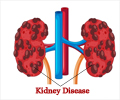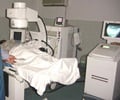A study in the June 13 issue of The Journal of Cell Biology says that the Aurora A kinase may contribute to polycystic kidney disease (PKD) by inactivating a key calcium channel in kidney cells.

The researchers found that Aurora A was up-regulated and activated in epithelial cells lining the cysts in PKD patient kidneys. In addition, Aurora A bound to and phosphorylated a calcium channel called polycystin-2, whose gene, PKD2, is often mutated in autosomal dominant forms of PKD.
Polycystin-2 mediates the release of calcium from storage in the endoplasmic reticulum and calcium influx into cilia. Inhibition or knockdown of Aurora A boosted intracellular calcium levels, but this effect was less pronounced in kidney cells lacking polycystin-2, indicating that Aurora A normally lowers calcium levels by inactivating polycystin-2. Only small doses of inhibitor were required to increase calcium levels, suggesting that Aurora A may be a viable therapeutic target for boosting polycystin-2 activity in certain PKD patients. Senior author Erica Golemis now wants to investigate how Aurora A becomes up-regulated in PKD and whether inhibitors of the kinase can slow cyst formation in mouse models of the disease.
###
About The Journal of Cell Biology
Founded in 1955, The Journal of Cell Biology (JCB) is published by The Rockefeller University Press. All editorial decisions on manuscripts submitted are made by active scientists in conjunction with our in-house scientific editors. JCB content is posted to PubMed Central, where it is available to the public for free six months after publication. Authors retain copyright of their published works and third parties may reuse the content for non-commercial purposes under a creative commons license. For more information, please visit www.jcb.org.
Plotnikova, O.V., and E.A. Golemis. 2011. J. Cell Biol. doi:10.1083/jcb.201012061.
Advertisement














